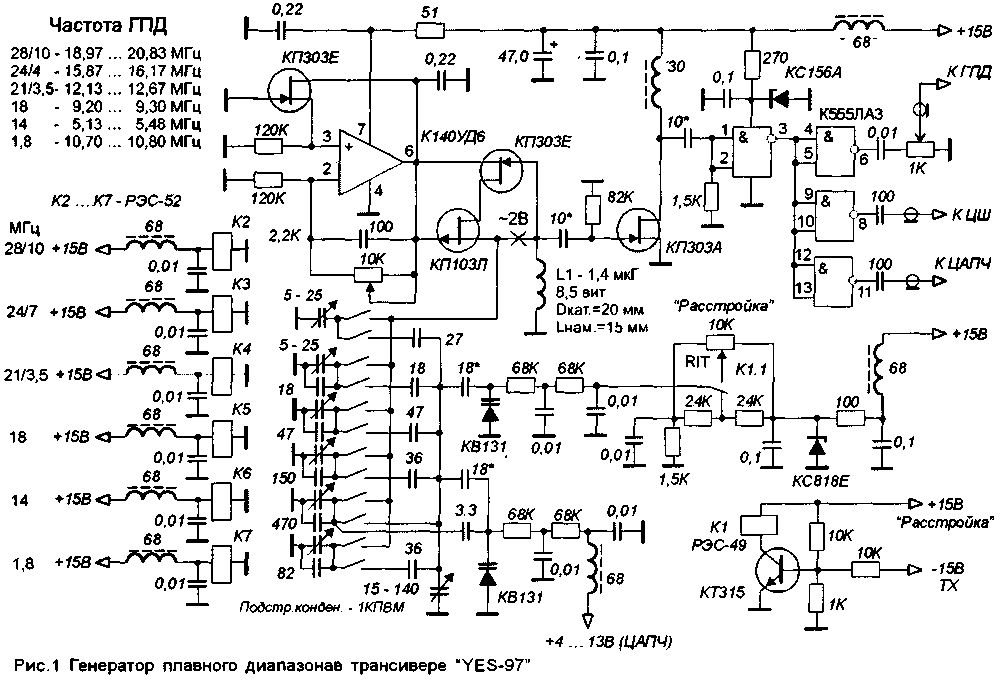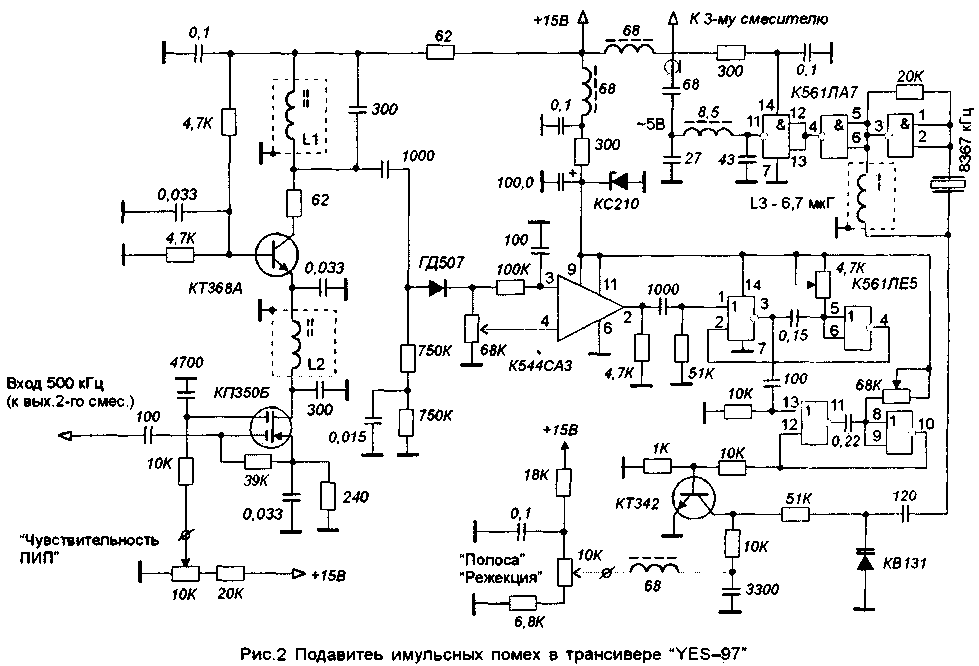
|
|
ENCYCLOPEDIA OF RADIO ELECTRONICS AND ELECTRICAL ENGINEERING Transceiver YES-97 (continued). Encyclopedia of radio electronics and electrical engineering
Encyclopedia of radio electronics and electrical engineering / Civil radio communications Having previously considered the main components of the YES-97 transceiver, we kind of left one of its most important components, the GPA, "overboard". Therefore, in an effort to correct this oversight, we present its schematic diagram and a brief description of the work. I especially want to emphasize that the transceiver's GPA is universal, the output parameters are stored in a wide range of generated frequencies, and it can certainly be used in similar amateur radio designs. In this case, frequency overlaps by ranges are determined and set independently, RW3AY.GPA - smooth range generator The GPA transceiver favorably differs from known similar units primarily by high frequency stability, a wide range of overlapping frequencies and a highly stable output signal amplitude. The frequency generator is assembled on field-effect transistors that implement the function of a lambda diode. The normal mode of operation is supported by a thermo-independent voltage regulator assembled on a K 140UD6 microcircuit. The ranges are switched by relay switches, which provide the connection of loop capacitors, both stretching capacitors and setting the boundaries of the ranges. The generated voltage passes through the buffer stage on the KP303A transistor and through the driver on the K555LAZ chip, which also branches the GPA signal. The "RX detuning" mode is provided by two KB 131 varicaps. They also perform additional stabilization of the GPA by a digital locked loop (DAFC) circuit. Schematic diagram of the GPA transceiver "YES-97" is shown in Fig.1. Coil L1 in the frequency generator is special, a suitable coil made of high quality radio porcelain with cast copper is used. It is known that the stability of the GPA frequency depends on the quality of its manufacture. Setting up the GPA is a very painstaking job, and it begins with setting a constant voltage on the lambda diode of about 2,7 V (K140D6, pin 6). Then the AC voltage on the L1 circuit is checked over the entire frequency range from 5 to 21 MHz. Its maximum value is about 2 V. Band trim capacitors are made up of several capacitors with different TKEs to provide the necessary long-term frequency stability without a connected DAC. If necessary, elements marked with asterisks (*) are selected. Surge Suppressor - PIP An impulse noise suppressor (PIP) can be proposed for installation in radio receivers with double frequency conversion. The operation of the PIP is based on the frequency shift of the second local oscillator. If sufficiently narrow-band filters are installed in the path of the first and second IF receivers, then changing the frequency of the second local oscillator by several kilohertz to the side will lead to the fact that the signal and interference will no longer fall into the passband of the second filter. The PIP is based on the scheme published in the Radio magazine No. 9-98 on pp. 24-27. In the same article, the principles and methods of dealing with impulse noise are well described, so it makes no sense to repeat them here. I will dwell only on the introduction of PIP into the radio receiver path. Schematic diagram of the PIP transceiver "YES-97" is shown in Fig.2. Realizing that there is no "universal" receiver, and there may be differences in its construction - with one or more frequency conversions, I will give a way to connect a PIP to a receiver with a low intermediate frequency of 500 kHz. From the output of the 2nd mixer of the radio receiver (500 kHz), the interference signal, together with the received signal, is fed to the input of a cascode amplifier based on transistors KP350B and KT368A, amplified, and then detected by a pulse detector on the GD507. The detected signal comes to the input of the K544SAZ comparator. The comparator threshold is set by a 68 kΩ variable resistor. At the output of the comparator, rectangular pulses are generated corresponding to interference pulses that are fed to the delay circuit assembled on the K561LE5 microcircuit. The delay time corresponds to the transit time of the interference signal from the 2nd to the 3rd mixer. Usually, this time may vary (depending on the actual receiver circuit), but does not exceed 1-10 ms. The delay time is selected by a 4,7 kΩ resistor. After its expiration, a rectangular pulse is formed, corresponding to the duration of the interference pulse. With a 68 kΩ variable resistor, the duration of this pulse can be adjusted from 2 to 50 ms, it is desirable to control its shape and duration with an oscilloscope. The control pulse that appears opens the KT342 transistor, which closes the KV131 varicap bias circuit to the case, which leads to an abrupt (5-6 kHz) decrease in the frequency of the reference oscillator assembled on the K561LA7 chip. The 8367 kHz sinusoidal signal from the output of the reference frequency generator is fed to the receiver's SSB/CW mixing detector, sometimes referred to as the third mixer. The operation of the PIP leads to the attenuation of the interference signal by more than 80 dB, without tangible switching interference. The PIP is tuned by ear, but it is desirable to control the shape and duration of the pulses using an oscilloscope. For more thorough tuning, it is advisable to use some kind of pulse generator with adjustable frequency and duty cycle of the output signal. The more precise the setting, the better it works. A variable resistor of 68 kΩ is used to finalize the turn-off time of the receiving path. It should be taken into account that it should not exceed 10% of the time of the interference pulse, otherwise there will be a temporary loss of the useful signal. The PIP node is placed on a small printed circuit board made of 2-sided fiberglass, placed in a metal shielding case. Coils L1 and L2 (in a cascade amplifier) can be taken from the 465 kHz IF of any transistor broadcast receiver. Author: G.Bragin, RZ4HK Chapaevsk; Publication: N. Bolshakov, rf.atnn.ru
Machine for thinning flowers in gardens
02.05.2024 Advanced Infrared Microscope
02.05.2024 Air trap for insects
01.05.2024
▪ Climate change has affected the taste of coffee ▪ Samurai brushing their teeth ▪ Digital wallet instead of paper and plastic documents ▪ CIA in the fight against global warming
▪ site section Chargers, accumulators, batteries. Article selection ▪ article Life is short, art is eternal. Popular expression ▪ article Who wrote the black square a quarter of a century before Malevich? Detailed answer ▪ article Field radish. Legends, cultivation, methods of application ▪ article Obedient ball. physical experiment
Home page | Library | Articles | Website map | Site Reviews www.diagram.com.ua |






 Arabic
Arabic Bengali
Bengali Chinese
Chinese English
English French
French German
German Hebrew
Hebrew Hindi
Hindi Italian
Italian Japanese
Japanese Korean
Korean Malay
Malay Polish
Polish Portuguese
Portuguese Spanish
Spanish Turkish
Turkish Ukrainian
Ukrainian Vietnamese
Vietnamese


 Leave your comment on this article:
Leave your comment on this article: